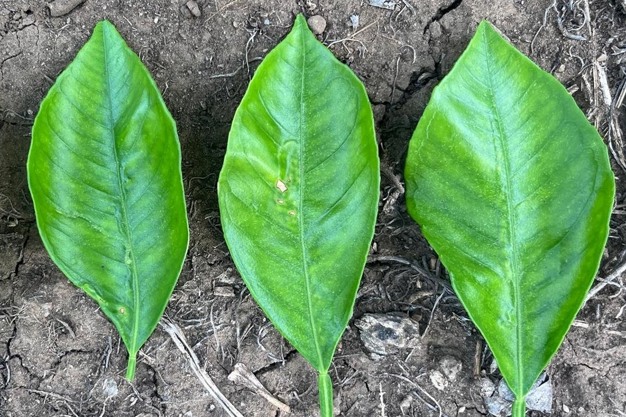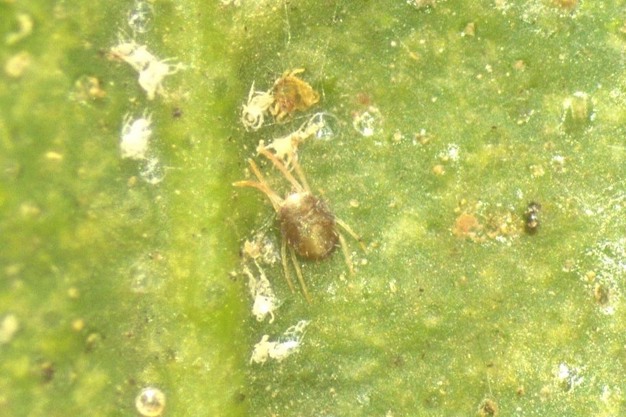At the end of August this year, the presence of a widespread infestation caused by a new phytophagous mite introduced into Italy was confirmed following numerous reports from citrus growers in the Piana di Catania area, the largest citrus growing region in Italy.
 Impact of the presence of Eutetranychus orientalis (Klein)
Impact of the presence of Eutetranychus orientalis (Klein)
Laboratory morphological analyses have identified the brown or oriental citrus mite, Eutetranychus orientalis (Klein), a tetranychid mite native to the Middle East and already reported in several Mediterranean countries (Spain, Greece, Tunisia, Morocco, Egypt and Turkey) and in Serbia.
The presence of the species, which is new to Italian territory, has been reported to the competent bodies of the Region and the Ministry. The species is not on the quarantine list.
The appearance of the phytophage in our territory is probably due to the movement or trade of infested plant material from Mediterranean countries where such populations are already present.
Citrus fruits are one of the main host plants of E. orientalis. In Spain, studies have shown that the mite has a strong preference for lemons, followed by oranges, while it is more occasionally found on clementines and mandarins. However, the species has been reported on around 150 host plants, including avocado, mango, peach, plum and quince.
Eutetranychus orientalis differs morphologically from the common red spider, Tetranychus urticae (which lives on the underside of leaves and produces abundant webs), and especially from the citrus red spider, Panonychus citri, in the shape and colour of the eggs, the low production of webs and the different morphological characteristics of the different biological stages.
Similar damage is caused by the bites, which appear as silvery-grey spots on the upper surface of the leaves. In the most severe cases, especially in plants suffering from water or nutrient deficiencies, phylloptosis and drying up of the branches may occur. In Sicily, however, this has not yet been reported, despite the hot summer we have just had.
 Eutetranychus orientalis (Klein)
Eutetranychus orientalis (Klein)
On the leaves, E. orientalis can be found along the midrib and secondary veins of the upper sides, where the exuviae of the mutated mites and the round, rather flattened eggs can also be observed. The species prefers the outer, sunnier areas of the canopy. Infestation of unripe sweet orange fruit, especially in the exposed areas, results in a slight discolouration tending towards silver. Experience in Spain has shown that the effect is temporary and the discolouration tends to disappear with ripening. The overall negative impact of the pest on citrus production is generally considered to be low, but favourable climatic or microclimatic conditions may favour outbreaks.
The first surveys carried out at district level show that the mite can spread actively and rapidly, as it did in Spain a few years ago (the mite was reported in the Iberian Peninsula in 2001), thanks to the establishment of local conditions favourable to its reproduction.
Control methods used in countries where the species is currently widespread include the use of paraffin oil when the presence of the mite is conspicuous. The use of specific acaricides may be necessary when significant phylloptosis occurs.
The use of synthetic acaricides where populations are not particularly conspicuous is ineffective, if not detrimental, as these molecules are harmful to the many natural enemies that normally manage to keep mite populations within acceptable limits.
Natural enemies include thrips of the genus Scolothrips spp., the coccinellid Stethorus punctillum and numerous species of predatory phytoseid mites naturally present in all citrus groves, such as Amblyseius andersoni, Euseius stipulutus, Iphiseius degenerans, Neoseiulus barkeri, N. californicus, Phytoseiulus persimilis and Typhlodromus spp.
The study was carried out by Giuseppe Massimino Cocuzza, Giovanna Tropea Garzia (Department of Agriculture and Food, University of Catania); Riccardo Tumminelli (Plant Disease Observatory, Phytosanitary Service, Ministry of Agriculture, Ministry of Agriculture, Rural Development and Mediterranean Fisheries, Region of Sicily, Acireale).










